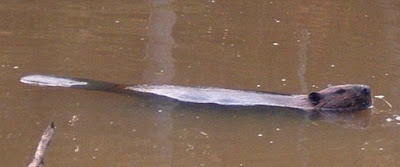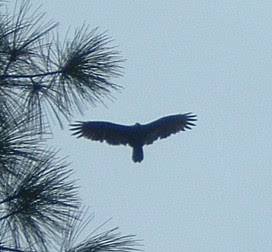In the early 1900s the State of New York began restoring beavers in the Adirondacks, the state's principal wilderness area that fills most of the northeast section of the state. In 1910 the Adirondacks included between 5000 and 6000 square miles of mostly forested mountains, lakes, plateaus, but villages, sawmills and mines as well. By then it had been settled with about 100,000 permanent residence and timber and mineral resources had been tapped for a century. Most of the report just pinpoints where beavers have been seen. I hope to include maps soon so better sense can be made out of the spread of the beavers from 1905 to 1914, but there is a poetry in all the names of lakes and streams, for anyone who likes beavers.
from State of New York
Fourth Annual Report of the Conservation Commission 1914
Return of Beavers to the Adirondacks
The beaver has been restored to his favorite haunts, the Adirondacks, by means of restocking and effective protection, according to the reports of systematic observations of protectors and others received by the Conservation Commission. These investigations show that there are to-day between 1,500 and 2,000 beaver in the wilds, which the Iroquois Indians called "Koh-sa-ra-ga," "The Beaver-Hunting-Country," and whose ownership was challenged by the Canadian tribe, styled in derision by the Mohawks, the "Adirondacks," the "Tree Eaters."
The Adirondacks to-day are again entitled to their old Iroquois name, for they are rapidly becoming the country of the Beaver, although this favorite fur bearing animal is no longer persecuted by the trapper and hunter.
The Legislature of 1903 appropriated $500 to begin the restocking of the Adirondacks with beaver and in 1905 three pairs were liberated. One pair were given their liberty on a small stream entering the south branch of Moose river, where another beaver which had escaped from the Woodruff preserve had built a dam. The other four were liberated on the northeast inlet of Big Moose Lake, but moved over into Beaver river, twenty miles ot the northeaast, to being housekeeping. During 1905 Edward H. Litchfield liberated about a dozen beavers in his preserve near Big Tupper Lake, and several of these escaped into adjoining preserves.
In 1905 there was reported to the Fish and Game Commission the existence of a "small native colony of beavers, the last of the remnants of the original stock, inhabiting the waters northwest of upper Saranac Lake." That year the Commission placed a "conservation estimate of the beaver in the Adirondacks" at "about forty." (p 252)
In 1906 the Legislature appropriated $1,000 for continuing the restocking of the Adirondacks with beaver and the following year seventeen were obtained from Yellowstone Park and distributed. The Commission gave the beaver census that year at 100.
In 1904, about the time the State of New York began its work of restoring the beaver to his native habitat, an authority on "American Animals" recorded in his book the sad fact that "the beaver is now nearly extinct in the United States." Much general interest has been displayed in the work of restoration in this State and the Conservation Commission is happy to say that popular co-operation has made the task of protecting Castor canadensis a comparatively easy one .
The reports received by the Conservation Commission show that beaver are multiplying rapidly and are taking possession of their ancient heritage in many different sections of the Adirondacks.
Colton District. Protector Smith of Colton reports three colonies in his territory of the Raquette river country.
Cranberry Lake District. Protector Hand of Cranberyy Lake records 1 colony on Grasse river below the reservoir; 1 colony on Cranberry Lake Inlet; 1 colony on Bog river; and "signs in the Town of Webb."
Croghan District. Protector Andre of Croghan reports 2 colonies at Sunday Lake; 1 at Stillwater, Beaver river; 1 at Francis Lake; 1 at upper end of Watertown Light and Power dam; 2 on west branch of Oswegatchie river. All "good sized colonies with large houses." Also a few beaver scattered in various places, without permanent habitat as yet.
Forestport District. Protector Bellinger of Forestport reports 3 colonies on the Black river; 1 at Kayuta pond; 1 three miles above Enos where they have built a dam; 1 on the Stillwater below North Lake; 1 colony on north branch of North Lake; 1 colony on second Stillwater above Honondaga Lake on West Canada Creek; several colonies on Indian river. Also reported by protector Ball, 1 colony on Wintime pond; 1 on Little Black Creek; 2 on Twin Lakes streams; 3 on Big Woodhull streams.
Fulton Chain District. Protector Ball of Old Forge enumerates and locates no less than 79 colonies, with 76 dams, inhabited by 223 beaver. The beaver locations in Ball's district are: Old Forge Pond, Big Spring Creek, First Lake and marshes, Second Lake, Third Lake, Fourth Lake, Fifth Lake, Sixth Lake, Seventh Lake, Eighth Lake, Cedar Creek, Black Mt. Creek, Eagle Creek, Limekiln Creek, Red river, Indian river (mostly bank beaver), Nick's Lake, Dry Lake (not dry now, flooded by beaver), Moose river (bank beaver), Hellgate Creek, Indian Spring Creek, Inlet of Big Otter, North Branch above Fulton Chain, Rondax Lake, Snake Pond, Chub Pond, Constable Pond, Queer Lake, south and west branches Beaver river.
J. Gilbert Hoffman, of Fulton Chain, finds that the beaver are increasing rapidly in various sections he has visited. He found a colony at Red Horse Chain and others reported by protectors. In that territory the intelligent animals have apparently lost most of their natural fear of man. A beaver dam on Eagle Creek which caused the flooding of the highway, was torn down under the direction of Protector Ball. The beaver reconstructed the dam over night. In another interesting case, the beaver insisted on invading Dr. Nicholl's property on First Lake. Protector Ball placed a lighted lantern in a lodge of the intruders, but they refused to take the hint to move on and, industriously extended their lodge over and around the warning beacon. Then in order to circumvent the trespassing beaver, the men put up a wire fence so the beaver could not get into Nicholl's yard where they were cutting poplars for food. Thereupon the wily animals vindicated the assertion of a scientist who said that "beaver apparently (sic) depend more upon reason and less upon instinct than do the majority of the forest folk." They piled wood against the fence and easily climed (sic) over into the forbidden territory.
Mr. Hoffman says the Brown's Tract Lumber Company is glad to see the beaver restored to the Adirondacks. In his opinion they do no great damage except in rare cases where they become so tame as to invade summer camp groves.
Glenfield District. Protector VerSnyder of Glenfield reports the beaver numerous in his section: 1 colony at Mud Hole Pond; 1 at Little Pine Lake; 1 on Pine Creek; 1 on Crawford's Fish Pond. Protector Quirk of Pulaski reports that he has not learned of any beaver in Oswego County. He has information of 1 colony on Crooked Creek, Lewis County, one mile from the south end of Stoney Lake, and 1 colony east of the north end of Stoney Lake in Independence river.
Gloversville District. Protector Masten reports that "the beaver made several visits to Fulton County," but founded no permanent colonies. It is possible that the few beaver in that section are "bank dwellers," as the animals, when disturbed by or not yet accustomed to civilization, do not build lodges.
Keene District. Protector Seckington, Elizabethtown, reports in September a beaver colony at Hull's Falls, town of Keene. On December 10 he reported discovering a new colony which has constructed a dam about 75 feet long, and flooding about 25 acres, on Gates Brook. The animals have built a lodge 15 feet in diameter accommodating 10 to 12 beaver.
Lake Pleasant District. Protector Howland of Speculator, reports very numerous in his territory: On Miami river, two dams with at least 20 beaver at each, and a third dam building in September on that river; 1 colony on Mill Brook; 2 large dams on Whitney Creek. To support the first dam, the beaver have built a dam half a mile below, backing up the water to it that distance. The first dam floods the stream one mile. One small colony on Mosey Fly stream. One large dam on outlet of Spencer Lake, with back water of two miles, inhabited by at least 200 beaver. Large colony and dam on north branch of Sacandaga river, with 30 to 40 inhabitants. Beaver in September were building a new dam on Samson Lake outlet and colony is established there.
Long Lake District. Protector Butler of Long Lake reports at least 30 beaver in his section. He makes this observation of special interest to the trout anglers: "The people living in this section think the beaver are doing fine and are glad to see them back. They tell me the beaver are a protection to our small streams containing trout, because the beaver builds dams and flood the marshes back of the dams. This makes it hard for the fishermen to fish all the pools and gives the trout a chance to grow."
Newcomb District. Protector Bissell of Newcomb reports 2 large colonies in the town of North Hudson; 1 colony in the town at Minerva and 4 colonies in the town of Newcomb.
Plattsburgh District. Protectors North and Kirby report from Plattsburgh that they found a "good sized colony" of beaver on Smith's Kiln Brook, town of Saranac, Clinton country. The animals have built a dam 35 feet long, flooding an acre.
Protector Riley of Plattsburg learned that the colony which had established itself near the mouth of the Ausable river last spring had moved up near Ausable Forks.
Protector Kirby of Brainardsville makes report of a colony on Redford Brook.
Raquette Lake District. Protector Lynn of Raquette Lake makes a detailed report of numerous colonies in his territory, showing over 250 beaver inhabitants. His record of locations is as follows: In Township 40, colonies on Bowlder Brook; 1 on Beaver Brook; 1 on Otter Brook; 2 on Brown's Tract Inlet; 1 on Brandeth Lake stream; 1 on Marion river. In Township 41, 1 colony on Cascade Lake stream; 1 on Shallow Lake stream; 1 on Cranberry Pond; 1 on Eagle Creek; 2 on Two Sisters Pond. In Township 39, 2 colonies on north branch of Shingle Shanty stream; 1 on East Pond. In Township 36, 1 colony on Big Salmon Lake; 1 on Carey Pond; 1 on Rack Pond stream; 1 on Flat Fish Pond; one on Bottle Pond stream. In Township 35, 1 colony on Loose Pond stream; 2 on North Bay Brook, Forked Lake; 1 on Upper Sargeant Pond. In Township 34, 2 colonies on Utawanta Lake; 1 on Loon Brook. In Township 6, 1 colony on Marion river; 2 on South Inlet; 1 on Bear Brook. In Township 5, 1 colony on Brown's Tract Pond. In Township 3, 2 colonies on Hess Pond; 1 colony on Fifth Lake; 1 colony on Seventh Lake; 2 colonies on Red river. In Township 4, 2 colonies on Falls Pond; 2 colonies on Mitchell Pond; 1 on Summer Creek; 2 on Indian river.
St. Regis District. William Bump, a caretaker of the Brooklyn Cooperage Company's tract on the St. Regis river, reports the beaver becoming quite numerous around the Ten Mile. Henry House of the Five Mile Camp, St. Regis river, found several families of beaver on Alder Brook.




























